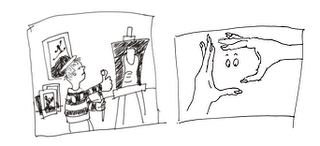
Is This Poetry?
Look again at this drawing of signs found on an Olmec carving. Art Decoded’s September 20th blog mentioned the Science article that suggested this stone may be the oldest Olmec writing found. Dated around 900 bce, it not only pre-dates the writing we’ve already found, but also suggests there must be much earlier writing around—if only we could find it.
But in a recent report from Brown University, another look at the stone reveals that some glyphic symbols are arranged in a way that suggests poetry. Repeated glyphs might represent repeated sounds like those used in poetic couplets. Here’s an example:
There was a Young Lady of Norway,
Who casually sat on a doorway;
Can you spot the repeated glyphs? This might be an interesting exercise for artists—create symbols for concepts and arrange them in a visual poetry.




